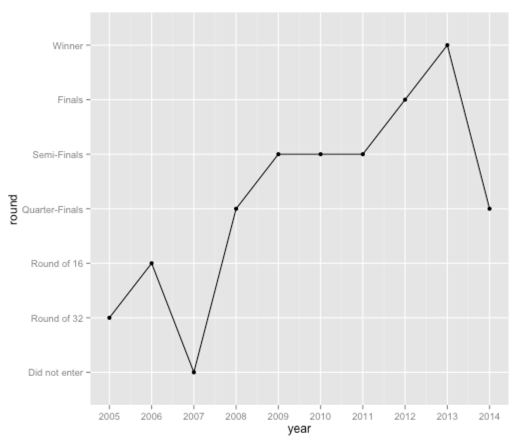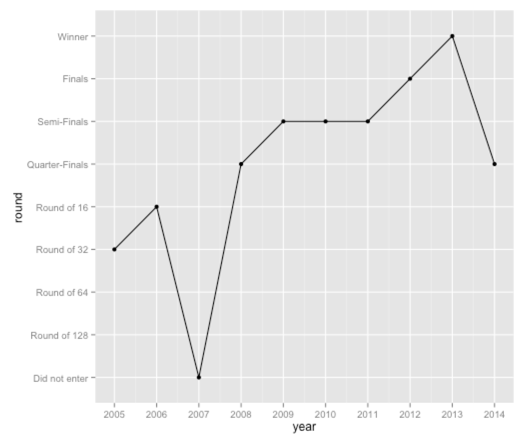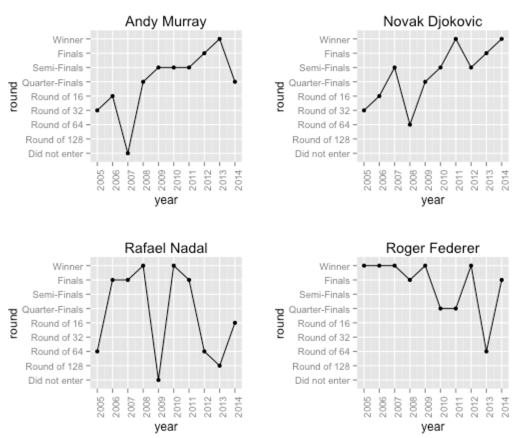R: ggplot - Show discrete scale even with no value
As I mentioned in a previous blog post, I’ve been scraping data for the Wimbledon tennis tournament, and having got the data for the last ten years I wrote a query using dplyr to find out how players did each year over that period.
I ended up with the following functions to filter my data frame of all the matches:
round_reached = function(player, main_matches) {
furthest_match = main_matches %>%
filter(winner == player | loser == player) %>%
arrange(desc(round)) %>%
head(1)
return(ifelse(furthest_match$winner == player, "Winner", as.character(furthest_match$round)))
}
player_performance = function(name, matches) {
player = data.frame()
for(y in 2005:2014) {
round = round_reached(name, filter(matches, year == y))
if(length(round) == 1) {
player = rbind(player, data.frame(year = y, round = round))
} else {
player = rbind(player, data.frame(year = y, round = "Did not enter"))
}
}
return(player)
}When we call that function we see the following output:
> player_performance("Andy Murray", main_matches)
year round
1 2005 Round of 32
2 2006 Round of 16
3 2007 Did not enter
4 2008 Quarter-Finals
5 2009 Semi-Finals
6 2010 Semi-Finals
7 2011 Semi-Finals
8 2012 Finals
9 2013 Winner
10 2014 Quarter-FinalsI wanted to create a chart showing Murray’s progress over the years with the round reached on the y axis and the year on the x axis. In order to do this I had to make sure the 'round' column was being treated as a factor variable:
df = player_performance("Andy Murray", main_matches)
rounds = c("Did not enter", "Round of 128", "Round of 64", "Round of 32", "Round of 16", "Quarter-Finals", "Semi-Finals", "Finals", "Winner")
df$round = factor(df$round, levels = rounds)
> df$round
[1] Round of 32 Round of 16 Did not enter Quarter-Finals Semi-Finals Semi-Finals Semi-Finals
[8] Finals Winner Quarter-Finals
Levels: Did not enter Round of 128 Round of 64 Round of 32 Round of 16 Quarter-Finals Semi-Finals Finals WinnerNow that we’ve got that we can plot his progress:
ggplot(aes(x = year, y = round, group=1), data = df) +
geom_point() +
geom_line() +
scale_x_continuous(breaks=df$year) +
scale_y_discrete(breaks = rounds)
This is a good start but we’ve lost the rounds which don’t have a corresponding entry on the x axis. I’d like to keep them so it’s easier to compare the performance of different players.
It turns out that all we need to do is pass 'drop = FALSE' to scale_y_discrete and it will work exactly as we want:
ggplot(aes(x = year, y = round, group=1), data = df) +
geom_point() +
geom_line() +
scale_x_continuous(breaks=df$year) +
scale_y_discrete(breaks = rounds, drop = FALSE)
Neat. Now let’s have a look at the performances of some of the other top players:
draw_chart = function(player, main_matches){
df = player_performance(player, main_matches)
df$round = factor(df$round, levels = rounds)
ggplot(aes(x = year, y = round, group=1), data = df) +
geom_point() +
geom_line() +
scale_x_continuous(breaks=df$year) +
scale_y_discrete(breaks = rounds, drop=FALSE) +
ggtitle(player) +
theme(axis.text.x=element_text(angle=90, hjust=1))
}
a = draw_chart("Andy Murray", main_matches)
b = draw_chart("Novak Djokovic", main_matches)
c = draw_chart("Rafael Nadal", main_matches)
d = draw_chart("Roger Federer", main_matches)
library(gridExtra)
grid.arrange(a,b,c,d, ncol=2)
And that’s all for now!
About the author
I'm currently working on short form content at ClickHouse. I publish short 5 minute videos showing how to solve data problems on YouTube @LearnDataWithMark. I previously worked on graph analytics at Neo4j, where I also co-authored the O'Reilly Graph Algorithms Book with Amy Hodler.
